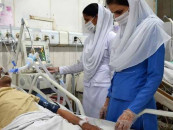Visual impairment can be avoided or treated: experts
Experts speaking at a seminar at AKU on World Sight Day said vision problems can be treated through regular check-ups.

Raising awareness and educating people about issues which can lead to vision impairment is key to helping every person have a 'Right to Sight', the theme of this year's Day.
They pointed out that over four-fifths of people whose eyesight is affected live in low and middle-income countries, including Pakistan.
Yet the World Health Organization has said that 80 per cent of blindness in adults and 85 per cent of moderate and severe visual impairment is preventable or treatable.
Age-related cataract is the leading cause of blindness but cataract surgery is one of the safest, most common and cost-effective surgical procedures according to Dr Shaukat Chhipa.
It is a simple surgical procedure that together with eye glasses can make a radical difference to a person's vision.
Another common cause of vision loss among people over 60 is macular degeneration, with people with diabetes needing to be especially careful.
Dr Azam Ali mentioned how, today, with modern treatment options and surgical techniques, degeneration can be controlled if not cured. This is also true of glaucoma, the second leading cause of blindness worldwide. It can be treated through medication said Dr Mahnaz Shah.
Detailed lectures were also delivered by Dr Sharmeen Akram on red eye and Dr Rashid Baig on ocular trauma or eye injury.
The World Health Organisation report on blindness has 10 facts about blindness and visual impairment:
Fact 1: Worldwide, about 314 million people are visually impaired due to various cases; 45 million of them are blind.
Fact 2: 153 million are visually impaired because of uncorrected refractive errors (near-sightedness, far-sightedness or astigmatism). Almost all of them could have normal vision restored with eyeglasses, contact lenses or refractive surgery.
Fact 3: Over 85% of visually impaired people live in low- and middle-income countries.
Fact 4: 39% of all blindness is due to age-related cataract, the leading cause of blindness.
Fact 5: Cataract surgery and correction of refractive errors are among the most cost-effective health interventions.
Fact 6: Age-related causes of visual impairment and blindness are increasing, as is blindness due to uncontrolled diabetes.
Fact 7: Up to 80% of all blindness in adults is preventable or treatable. Among children, the major causes of avoidable blindness include cataract, retinopathy of prematurity (ROP), and Vitamin A deficiency.
Fact 8: Blindness caused by infectious diseases is decreasing globally due to public health action. Blinding trachoma affects 40 million people today, compared to 360 million in 1985.
Fact 9: Around 1.4 million children under age 15 are blind. Yet approximately half of all childhood blindness can be avoided by treating diseases early and by correcting abnormalities at birth such as cataract and glaucoma.
Fact 10: For decades, WHO has been working with global partners to eliminate the main causes of avoidable blindness, strengthening country-level efforts by providing technical assistance, monitoring and coordination.



















COMMENTS
Comments are moderated and generally will be posted if they are on-topic and not abusive.
For more information, please see our Comments FAQ